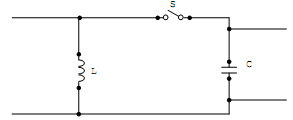Q. What are the performance measures of oscillator circuits?
1. Stability: This is determined by the passive components. R, C and L determine frequency of oscillations. If R changes with T, f changes so stability is affected. Capacitors should be of high quality low leakage. So silver mica and ceramic capacitors are widely used.
2. Amplitude stability: to get large output, amplification is to be done.
3. Output power: class A, B and C operations can be done. Class C gives largest output but harmonics are more.
4. Harmonics: Undesirable frequency components are harmonics. An elementary sinusoidal oscillator circuit is shown in figure.

L and C are reactive elements. They can store energy. The capacitor stores energy whenever there is voltage across its plates. Inductor stores energy in its magnetic field whenever current flows. Both C and L are lossless, ideal devices. So quality factor is infinity. Energy is introduced into the circuit by charging capacitor to 'V' volts. If switch is open, C cannot discharge because there is no path for discharge current to flow.
Voltage across C is V volts. When switch is closed, current flows. So the charge across capacitor C decreases and voltage across C decreases. so as the energy stored in capacitor decreases, the energy stored in inductor L increases, because current is flowing through L. thus total energy in the circuit remains the same as before. When V across C becomes 0, current through the inductor is maximum and the current starts charging C in the opposite direction. So V across C becomes negative. Thus we get sinusoidal oscillations from LC circuit.